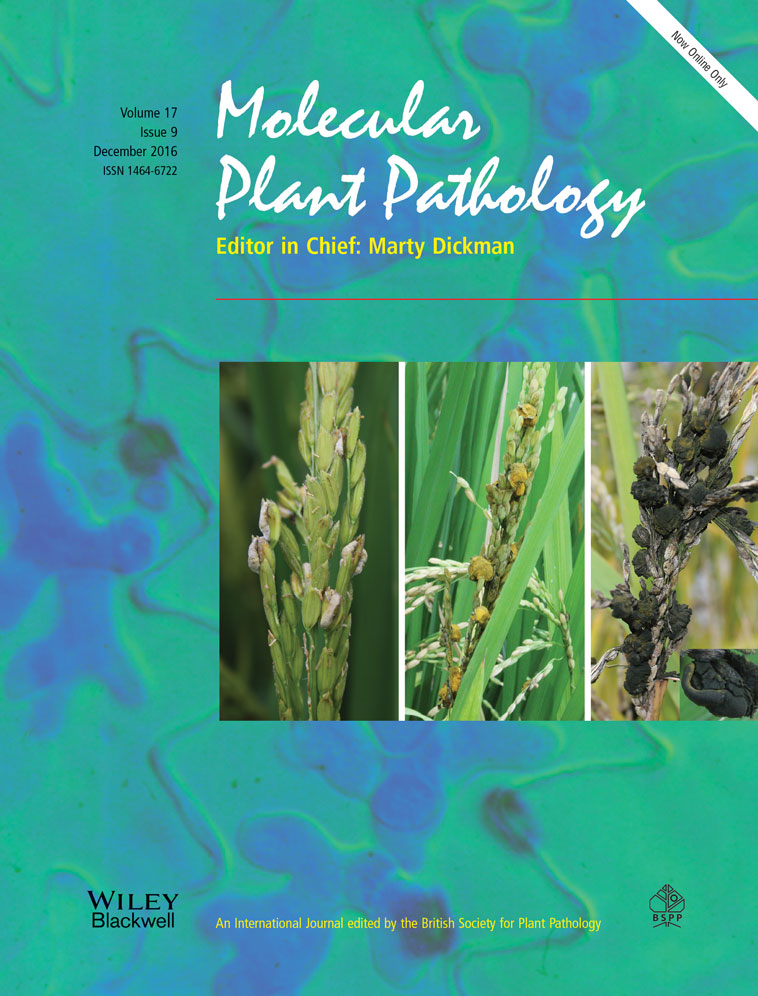View Item
- xmlui.general.dspace_homeCentros e Institutos de InvestigaciónCIAP. Centro de Investigaciones AgropecuariasInstituto de Fisiología y Recursos Genéticos VegetalesArtículos científicosxmlui.ArtifactBrowser.ItemViewer.trail
- DSpace Home
- Centros e Institutos de Investigación
- CIAP. Centro de Investigaciones Agropecuarias
- Instituto de Fisiología y Recursos Genéticos Vegetales
- Artículos científicos
- View Item
Silencing of the tomato phosphatidylinositol‐phospholipase C2 (SlPLC2) reduces plant susceptibility to Botrytis cinerea
Abstract
The tomato [Solanum lycopersicum (Sl)] phosphatidylinositol‐phospholipase C (PI‐PLC) gene family is composed of six members, named SlPLC1 to SlPLC6, differentially regulated on pathogen attack. We have previously shown that the fungal elicitor xylanase induces a raise of SlPLC2 and SlPLC5 transcripts and that SlPLC2, but not SlPLC5, is required for xylanase‐induced expression of defense‐related genes. In this work we studied the role of SlPLC2 in the
[ver mas...]
The tomato [Solanum lycopersicum (Sl)] phosphatidylinositol‐phospholipase C (PI‐PLC) gene family is composed of six members, named SlPLC1 to SlPLC6, differentially regulated on pathogen attack. We have previously shown that the fungal elicitor xylanase induces a raise of SlPLC2 and SlPLC5 transcripts and that SlPLC2, but not SlPLC5, is required for xylanase‐induced expression of defense‐related genes. In this work we studied the role of SlPLC2 in the interaction between tomato and the necrotrophic fungus Botrytis cinerea. Inoculation of tomato leaves with B. cinerea increases SlPLC2 transcript levels. We knocked‐down the expression of SlPLC2 by virus‐induced gene silencing and plant defense responses were analyzed upon B. cinerea inoculation. SlPLC2 silenced plants developed smaller necrotic lesions concomitantly with less proliferation of the fungus. Silencing of SlPLC2 resulted as well in a reduced production of reactive oxygen species. Upon B. cinerea inoculation, transcript levels of the salicylic acid (SA)‐defense pathway marker gene SlPR1a were diminished in SlPLC2 silenced plants compared to non‐silenced infected plants, while transcripts of the jasmonic acid (JA)‐defense gene markers Proteinase Inhibitor I and II (SlPI‐I and SlPI‐II) were increased. This implies that SlPLC2 participates in plant susceptibility to B. cinerea.
[Cerrar]

Author
Gonorazky, Ana Gabriela;
Guzzo, María Carla;
Abd El Haliem, Ahmed M.;
Joosten, Matthieu H. A. J.;
Laxalt, Ana Maria;
Fuente
Molecular plant pathology 17 (9) : 1354–1363. (December 2016)
Date
2016-12
Editorial
Wiley
ISSN
1364-3703 (Online)
Formato
pdf
Tipo de documento
artículo
Palabras Claves
Derechos de acceso
Restringido
 Excepto donde se diga explicitamente, este item se publica bajo la siguiente descripción: Creative Commons Attribution-NonCommercial-ShareAlike 2.5 Unported (CC BY-NC-SA 2.5)
Excepto donde se diga explicitamente, este item se publica bajo la siguiente descripción: Creative Commons Attribution-NonCommercial-ShareAlike 2.5 Unported (CC BY-NC-SA 2.5)

